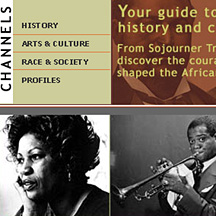|
New doors to old content Originally published in Current,
Oct. 21, 2002 CPB's recent investments in web-only production include two portal sites that aggregate PBS and NPR content in major cultural subject areas. Both serve up original content with links to websites related to broadcasts in past years-and in recent days. WNET's African American World and WGBH's Global Connections received CPB grants through separate initiatives, but their fundamental reasons for being are similar-to repackage program-related material into deep, evergreen tools for formal or fun learning. CPB has invested tens of millions of dollars on historical documentaries about African-Americans, but after broadcast it's difficult for people to find their companion websites unless they search for them specifically, explained Louis Barbash, the CPB project officer for the site. The portal "brings all of this content into one place" and extends its value to underserved audiences "in a way that a broadcast can't do."
Educational materials include a timeline, links to lesson plans created for many PBS documentaries, and a reference room with content from NPR, PBS and Encyclopedia Britannica. Since the site launched this summer, a kids' page with games and e-card features has become its most popular feature. Producers at WNET in New York designed the site for easy navigation through content that appeals to three different audiences-television viewers, educators and school-age kids, said Anthony Chapman, director of interactive and broadcast. Thorough searches of NPR.org and PBS.org found plentiful material, Chapman said. "I think that provided the sound argument of why a portal site was needed for this content. There was so much of it, and it was not organized or promoted in a way where people can easily get to it."
"When we looked at what teachers need, we saw something bigger," said Julie Benyo, director of special initiatives at WGBH. Editorial objectives for the site broadened into "trying to understand world events and putting 9/11 within that." Scholars from Harvard and the University of California in Los Angeles advised WGBH on research and production of the site. Portal elements of Global Connections are less obvious to users because links to other pubcasting sites supplement a substantial collection of original content. Timelines, background papers on cultural themes, and 17 lesson plans were created specifically for the site, Benyo said. Links take visitors to specific pages within websites. "Connecting Questions," an area of Global Connections that addresses misperceptions and thorny issues, offers links to many sources within and outside public broadcasting-the Library of Congress, NPR and The World, the NewsHour, and Vis a Vis, a program from the PBS library that encouraged cross-cultural dialogues. Web-only sites give online producers more creative leeway in design, research and production, Benyo said. "You can go in the direction you know is linked to what teachers need more than what the program has to offer." Portals have "an immediacy that TV lacks" because content is served up 'round-the-clock and on-demand, Chapman said. They also bring together pubcasting's most powerful brands and offer "infinite development space" for sites to evolve and grow over time. But because they aren't connected to a new program, the sites and their web addresses don't share in the promotion for the broadcast, Chapman said. "We miss the bump of the broadcast to bring viewers to it," added Benyo. Page views are growing "a little each week" less than two months after Global Connections launched. "We expect this to gain users as it finds its way into the curriculum and as we continue to work with educational organizations." The site is now subtitled "The Middle East," and WGBH plans to extend the Global Connections title to other regions. Producers are now creating a smaller site tied to an upcoming documentary on Liberia. "This is a web strand we plan to build out as a place where social studies teachers come to for content," Benyo explained. WNET has similar ambitions for African American World. Its second phase would help stations create their own sites on local African-American history. CPB is talking with PBS about creating promos for the site. PBS.org's top priority is presenting content that supports the broadcast schedule, said Cindy Johanson, senior v.p., interactive learning. She sees web-only production as a way to fill content gaps or "try new concepts that could eventually move to television." Portals are "one opportunity to aggregate content and provide context," she said. But web visitors can also use the PBS.org search engine to explore topics of their choice. PBS recently launched its own portal site, PBSParents, with funding from the federal Ready to Learn grant program. "The big question we have as we evolve our Internet presence is how effective aggregating content in portals is," Johanson added. "Web-only sites need at least a year to determine if usage rates justify continued investment." |
These days, transmitters have little or nothing to do with some things put out by public broadcasters. Current cites some sites: New doors to old content: WNET's African American World and WGBH's Global Connections Niche streamer: WAMU's BluegrassCountry.org Campaigns a la carte: NewsHour Online's Vote 2002 Webumentary tryout: P.O.V.'s Borders Toolmaker for station sites: Public Interactive. Follow the reporters: Frontline's pre-broadcast diary. |
 |
To Current's home page |
 |
Outside links: African American World and Global Connections. |
Web page posted Nov. 5,
2002
Current
The newspaper about public television and radio
in the United States
A service of Current Publishing Committee, Takoma Park, Md.
E-mail: web![]() current.org
current.org
301-270-7240
Copyright 2002

 African
American World is a guide to African-American history and culture that
prominently features online material from both NPR and PBS. The homepage
welcomes visitors with images of famous black Americans, database-driven
blurbettes such as quotes and this-day-in-history snippets that link
to detailed information. Main pages of four different channels-history,
arts and culture, race and society, and profiles-invite visitors to
post comments and reactions, and display links to NPR and PBS online
content side by side.
African
American World is a guide to African-American history and culture that
prominently features online material from both NPR and PBS. The homepage
welcomes visitors with images of famous black Americans, database-driven
blurbettes such as quotes and this-day-in-history snippets that link
to detailed information. Main pages of four different channels-history,
arts and culture, race and society, and profiles-invite visitors to
post comments and reactions, and display links to NPR and PBS online
content side by side. At
least six researchers at WGBH in Boston worked on the inventory that
built out Global Connections, a site about Middle Eastern history and
culture. WGBH originally proposed it as a web resource for teachers
on the Sept. 11, 2001 terrorist attacks, drawn from material on Frontline's
website.
At
least six researchers at WGBH in Boston worked on the inventory that
built out Global Connections, a site about Middle Eastern history and
culture. WGBH originally proposed it as a web resource for teachers
on the Sept. 11, 2001 terrorist attacks, drawn from material on Frontline's
website. 